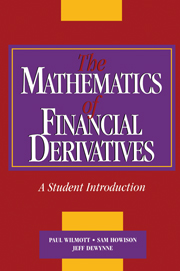Book contents
- Frontmatter
- Contents
- Preface
- Part One Basic Option Theory
- Part Two Numerical Methods
- Part Three Further Option Theory
- 11 Exotic and Path-dependent Options
- 12 Barrier Options
- 13 A Unifying Framework for Path-dependent Options
- 14 Asian Options
- 15 Lookback Options
- 16 Options with Transaction Costs
- Part Four Interest Rate Derivative Products
- Hints to Selected Exercises
- Bibliography
- Index
16 - Options with Transaction Costs
from Part Three - Further Option Theory
Published online by Cambridge University Press: 05 June 2012
- Frontmatter
- Contents
- Preface
- Part One Basic Option Theory
- Part Two Numerical Methods
- Part Three Further Option Theory
- 11 Exotic and Path-dependent Options
- 12 Barrier Options
- 13 A Unifying Framework for Path-dependent Options
- 14 Asian Options
- 15 Lookback Options
- 16 Options with Transaction Costs
- Part Four Interest Rate Derivative Products
- Hints to Selected Exercises
- Bibliography
- Index
Summary
Introduction
We have derived the Black–Scholes partial differential equation for simple option prices, we have discussed the general theory behind the diffusion equation and, in the last few chapters, we have generalised the Black–Scholes model to exotic options. We continue this generalisation with a model that incorporates the effects of transaction costs on a hedged portfolio. We describe the model only for vanilla options but it can easily be modified for exotic options.
Discrete Hedging
One of the key assumptions of the Black-Scholes analysis is that the portfolio is rehedged continuously: we take the limit dt → 0. If the costs associated with rehedging (e.g. bid-offer spread on the underlying) are independent of the timescale of rehedging then the infinite number of transactions needed to maintain a hedged position until expiry may lead to infinite total transaction costs. Since the Black-Scholes analysis is based on a hedged portfolio, the consequences of significant costs associated with rehedging are important. Different people have different levels of transaction costs; as a general rule there are economies of scale, so that the larger the trader's book, the less significant are his costs. Thus, contrary to the basic Black–Scholes model, we may expect that there is no unique option value. Instead, the value of the option depends on the investor.
Leland has proposed a very simple modification to the Black–Scholes model for vanilla calls and puts, which can be extended to portfolios of options, that introduces discrete revision of the portfolio and transaction costs.
- Type
- Chapter
- Information
- The Mathematics of Financial DerivativesA Student Introduction, pp. 252 - 262Publisher: Cambridge University PressPrint publication year: 1995



